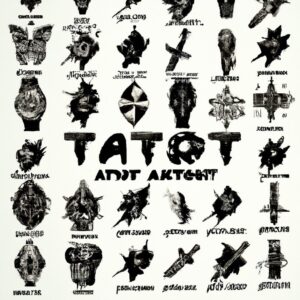
Introduction to the world of tattoos
Tattoos have come a long way from being just a symbol of rebellion to becoming one of the most expressive forms of art today. Tattoo enthusiasts are always on the lookout for unique designs that match their personalities, and what better place to find inspiration than tattoo paradise? In this blog post, we’ll take you on a journey through the world of tattoos – exploring its history, different types, culture and industry. So fasten your seatbelts as we venture into this artistic wonderland!
The history of tattoos
The history of tattoos is a fascinating one, spanning back thousands of years. The earliest evidence of tattooing can be traced back to ancient Egypt and the Middle East, where mummified bodies have been found with tattoos still intact. These tattoos were often symbols representing religious or spiritual beliefs.
In Japan, tattooing was originally used as a form of punishment before it became an art form in its own right. Japanese tattoo artists developed intricate designs that covered large areas of the body and often took years to complete.
Tattooing also had a significant role in Polynesian cultures, where intricate patterns were used to represent family lineage and social status. The Maori people of New Zealand are well-known for their traditional facial tattoos called moko.
In Western cultures, tattoos gained popularity in the 18th century among sailors who would get images on their skin as souvenirs from their travels. However, they didn’t become mainstream until the 20th century when celebrities began getting inked and popularizing the trend.
Today, people get tattoos for various reasons including self-expression, aesthetics, cultural significance or simply because they like how it looks on them. Regardless of why someone chooses to get inked today – whether it’s for personal meaning or just aesthetic pleasure – we can appreciate the rich history behind this timeless art form.
Different types of tattoos

When it comes to tattoos, there are numerous styles to choose from. Each style has a unique aesthetic that appeals to different people for different reasons. Here are some of the most popular tattoo styles:
1. Traditional: Also known as old school or American traditional, this style features bold lines and bright colors with designs often based on nautical themes.
2. Realism: This style aims to create an exact replica of a photograph or image onto the skin, creating a hyper-realistic effect.
3. Watercolor: This relatively new style replicates watercolor paintings, featuring soft edges and blending hues without harsh outlines.
4. Tribal: Originating from ancient tribal cultures around the world, these tattoos use black ink and intricate patterns to tell cultural stories or symbolize spiritual beliefs.
5. Japanese: Known for its elaborate designs and storytelling qualities, this style includes detailed depictions of nature scenes such as koi fish swimming upstream against turbulent waters.
Choosing which type of tattoo best suits you is just one step in your journey into tattoo paradise!
The tattoo culture
The tattoo culture is a fascinating aspect of the world of ink and art. It’s a community that transcends race, gender, and social status, bringing together people from all walks of life who share a passion for tattoos. The tattoo culture has been around for centuries, with different cultures having their unique way of expressing themselves through tattoos.
In recent years, the popularity of tattoos has grown exponentially as more people have started to view them as an art form rather than just body adornment. This shift in perception has helped to boost the visibility and acceptance of the tattoo culture globally.
One notable feature of the tattoo culture is its inclusivity – everyone is welcome regardless of their background or lifestyle choices. Tattoo enthusiasts gather at conventions and festivals worldwide to showcase their work, exchange ideas and learn new techniques.
Another fascinating aspect of this subculture is how it continues to evolve with advancements in technology and cultural changes. Tattoos have become more intricate thanks to modern equipment such as rotary machines that allow for precise detail work never before possible.
The tattoo culture represents an inclusive community where creativity knows no bounds; it’s full acceptance reigns supreme.
The tattoo industry
The tattoo industry has come a long way from its underground roots. Today, it’s a multi-billion dollar industry with millions of people getting inked every year. From small tattoo parlors to high-end studios, the tattoo industry offers something for everyone.
One of the biggest drivers of growth in the tattoo industry is social media. Instagram and other platforms have made it easier than ever for artists to showcase their work and attract clients from around the world.
But with this growth comes some challenges. The increased demand has led to more competition among artists, which can make it difficult for new talent to break through.
Another challenge facing the industry is regulation. While many states require licenses for tattoo artists, regulations can vary widely from one place to another. This lack of uniformity makes it difficult for consumers to know what standards they should expect when getting a tattoo.
Despite these challenges, there’s no denying that tattoos are more popular than ever before. As long as there are people who want them, there will be an industry dedicated to providing them with quality ink and artistry that lasts a lifetime.
Tattoo artists

Tattoo artists are the backbone of the tattoo industry. They bring life to designs and ideas that their clients have in mind, using their skills and creativity to turn them into permanent works of art on skin.
Every tattoo artist has their own style and technique, making each one unique. Some specialize in colorful pieces with intricate details, while others prefer black and gray work with bold lines and shading.
One important aspect of being a successful tattoo artist is having a good rapport with clients. Tattooing can be an intimate experience that requires trust between the client and artist. Good communication skills are crucial for understanding what the client wants, as well as explaining any concerns or limitations.
Tattoo artists also need to prioritize safety by following proper sanitation protocols to prevent infections or diseases from spreading. It’s important for clients to do research beforehand when choosing an artist so they can feel confident in their abilities.
Tattoo artists play a significant role in bringing people’s vision into reality through body art.
Conclusion
The world of tattoos is a fascinating and intricate one. From its ancient roots to modern-day trends, it has evolved into a beautiful art form that can express individuality, creativity, and personal meaning. Tattoo paradise is not only about the physical location but also about the state of mind that allows tattoo enthusiasts to immerse themselves in this world of ink.
It’s important to note that getting a tattoo requires careful consideration and research before making any permanent decisions. It’s crucial to find an experienced artist who prioritizes safety and hygiene while creating high-quality artwork.
Exploring the wonders of tattoo paradise can be both exciting and fulfilling for anyone interested in experiencing this unique art form firsthand. With so many styles, designs, meanings, and cultural influences within tattoos today – there truly is something for everyone in this captivating world.
“






